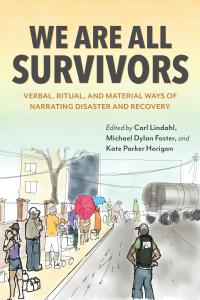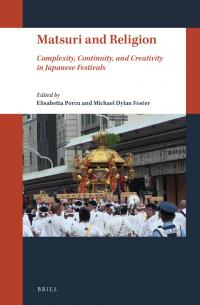
Position Title
Professor of Japanese
EDUCATION AND DEGREE(S)
- Ph.D., Japanese, Stanford University
- M.A., Asian Studies, University of California, Berkeley
- B.A., English, Wesleyan University
RESEARCH INTEREST(S)
- Japanese folklore
- Japanese literature
- Folkloristics (history/theory)
- Monsters/Supernatural
- Ritual and Festival
- Legend and Belief
- Tourism
- Intangible Cultural Heritage / Cultural Policy / UNESCO
RECENT MEDIA APPEARANCES
- Since 2022: Navigator for NHK World TV Series: "YOKAI: Exploring Hidden Japanese Folklore"
- Watch the latest episodes HERE
- 2024 UC Davis Letters & Sciences: Monster Hunting with Michael Dylan Foster
- 2024 “Namahage: They’re Coming For The Children, with Dr. Michael Dylan Foster” on Snow Country Stories Japan podcast; July 9, 2024
- 2022 Featured in Akita Sakigake Shinpō (newspaper); Feb 16, 2022
- 2020 “The Mysterious Hauntings of the Japanese Yokai,” on The Daily Smile podcast (with Nikki Boyer), posted Oct. 30
- 2020 “Return of the Yokai,” 99% Invisible, podcast posted June 23.
- 2020 Interviewed for France 24; posted May 20:
RECENT COURSES
- Introduction to Japanese Folklore (JPN 155)
- Japanese Popular Culture (JPN 109)
- The Culture of Japanese Food (JPN 160)
- Japan Travelogue: Ethnographic Writing on Japanese Culture and People (JPN 162)
- Tourism and Heritage in Japan (JPN 154)
PROFILE
I came to UC Davis in 2016 after eight years in the Department of Folklore and Ethnomusicology at Indiana University. Before that I worked at UC Riverside, in the Department of Comparative Literature & Foreign Languages, where I taught Japanese language, literature, folklore and film.
My research focuses on folklore, literature and popular culture, primarily in Japan. I am interested in how cultural phenomena and beliefs—particularly those associated with the supernatural—are articulated through textual and visual media as well as performance, ritual and everyday contexts.
I have written a lot about supernatural creatures and strange phenomena. My first book, Pandemonium and Parade: Japanese Monsters and the Culture of Yôkai (2009), is a cultural history that traces how notions of the mysterious have been understood within both academic discourses and popular practices from the seventeenth century through the present. I particularly explore how aspects of everyday life we often take for granted—games, rumors, popular beliefs—reflect broader cultural and historical changes.
My second book, The Book of Yôkai: Mysterious Creatures of Japanese Folklore (2015), also focuses on monsters and supernatural beings in Japan, exploring their roots, interpreting their meanings, and introducing many of the people who have studied, catalogued, and sought to define them. Through this interest in popular conceptions of monstrosity and the supernatural, I have also become interested in the concept of the “folkloresque,” how folklore is “used” within artistic, literary, filmic, and popular cultural contexts.
For over two decades now I have also engaged on a long-term ethnographic study of ritual, festival, and tourism in Japan. For this project, I have done extensive fieldwork on the Toshidon ritual on the island of Shimo-Koshikijima in Kagoshima Prefecture and the Namahage festival in Akita Prefecture. I also consider the work of Yanagita Kunio, Orikuchi Shinobu, Komatsu Kazuhiko and other folklorists. This research on festival/ritual has led me to think more deeply about tourism, intangible cultural heritage (ICH), and UNESCO. It also gave me a chance to help out on a Japanese fishing boat for several months, during which time I ate sashimi for breakfast every day.
SELECTED PUBLICATIONS
BOOKS
The Book of Yōkai: Mysterious Creatures of Japanese Folklore, Expanded Second Edition, University of California Press, 2024.

The Book of Yôkai: Mysterious Creatures of Japanese Folklore. Oakland: University of California Press, 2015.

Pandemonium and Parade: Japanese Folklore and the Culture of Yôkai. Berkeley: University of California Press, 2009.
[*Winner 2009 Chicago Folklore Prize for best book-length work of folklore scholarship

EDITED VOLUMES
Möbius Media: Popular Culture, Folklore, and the Folkloresque. Logan: Utah State University Press, 2024. Coedited with Jeffrey Tolbert.

We Are All Survivors: Verbal, Ritual, and Material Ways of Narrating Disaster and Recovery. Bloomington: Indiana University Press, 2022. Coedited with Carl Lindahl and Kate Horigan Parker.

Matsuri and Religion: Complexity, Continuity, and Creativity in Japanese Festivals. Leiden: Brill, 2021. Coedited with Elisabetta Porcu.

Matsuri and Religion in Japan; Special Triple Issue of Journal of Religion in Japan vol. 9, issues 1-3, 2020. Coedited with Elisabetta Porcu.
We are all Survivors: Verbal, Ritual and Material Ways of Narrating Disaster and Recovery; Special Issue of Fabula: Journal of Folktale Studies 58, issues 1-2, 2017. Coedited with Carl Lindahl.
The Folkloresque: Reframing Folklore in a Popular Culture World. Logan: Utah State University Press, 2016. Coedited with Jeffrey Tolbert.

UNESCO on the Ground: Local Perspectives on Intangible Cultural Heritage. Co-Edited with Lisa Gilman. Bloomington: Indiana University Press, 2015. Co-Edited with Lisa Gilman.

ARTICLES AND ESSAYS (SELECT)
“Nothing Is Original: Mimesis, Repetition, and the Spirit of Amabie.” In Möbius Media: Popular Culture, Folklore, and the Folkloresque. Edited by Jeffrey A. Tolbert and Michael Dylan Foster, 312-337. Logan: Utah State University Press, 2024.
“A Kappa Manifesto.” In Living With Monsters: Ethnographic Fiction about Real Monsters. Edited by Yasmine Musharbash and Ilana Gershon, 153-173. Punctum Books, 2023.
“New Foreword.” In Kwaidan: Terrifying Tales of Japanese Yokai, Ghosts, and Demons, by Lafcadio Hearn. Tuttle, 2022.
“Yōkai and Yanagita Kunio: A View from the 21st Century.” In Yanagita Kunio and Japanese Folklore Studies in the 21st Century. Edited by Ronald A. Morse and Christian Goehlert, Second Revised Edition, 11–34. Kawaguchi: Japanime 2021. [revised edition of 2012 publication]
“Cultural Heritage in the Age of Pandemic: A Review Essay.” Journal of Folklore Research Reviews; posted Sept. 3, 2020.
“Eloquent Plasticity: Vernacular Religion, Change, and Namahage,” Journal of Religion in Japan vol. 9, issues 1-3 (2020): 118-164.
“Secret Eroticism and Lived Religion: The Art of Matsuri Photography,” Journal of Religion in Japan vol. 9, issues 1-3 (2020) 277-300. (With Ogano Minoru).
“Afterword: Scenes from the Monsterbiome.” In Monster Anthropology: Ethnographic Explorations of Transforming Social Worlds through Monsters, edited by Yasmine Musharbash and Geir Henning Presterudstuen, 213-228. London: Bloomsbury Academic, 2020.
“UNESCO’s Intangible Cultural Heritage Convention.” E-International Relations (open access website); posted January 7, 2020.
“Foreword.” In Japanese Legends and Folklore: Samurai Tales, Ghost Stories, Legends, Fairy Tales, Myths and Historical Accounts, by A.B. Mitford. Rutland: Tuttle 2019, pp. 4-8.
“Yōkai: Fantastic Creatures of Japanese Folklore.” Online essay for “About Japan: A Teacher’s Resource” on Japan Society website, 2019.
“Kaisetsu: Mizuki no sekai.” In Mizuki Shigeru manga taizenshû hokan 4: Baitai betsu yôkai gahôshû IV, pp. 608-611. Kôdansha, 2018. [Invited afterword]
“The Intangible Lightness of Heritage,” Fabula: Journal of Folktale Studies 58, issues 1-2 (2017): 105-121.
“Murakami’s Monsters and the Art of Allusion.” In Takashi Murakami: The Octopus Eats Its Own Leg. Ed. Michael Darling, pp. 139-150. New York: Skira Rizzoli Publications, 2017.
“The Challenge of the Folkloresque.” In The Folkloresque: Reframing Folklore in a Popular Culture World. Eds. Michael Dylan Foster and Jeffrey A. Tolbert, pp. 3-22. Logan: Utah State University Press, 2016.
“The Folkloresque Circle: Toward a Theory of Fuzzy Allusion.” In The Folkloresque: Reframing Folklore in a Popular Culture World. Eds. Michael Dylan Foster and Jeffrey A. Tolbert, pp. 41-63. Logan: Utah State University Press, 2016.
“UNESCO on the Ground.” Journal of Folklore Research 52, no 2-3 (May-Dec) 2015: 143-156.
“Imagined UNESCOs: Interpreting Intangible Cultural Heritage on a Japanese Island.” Journal of Folklore Research 52, no 2-3 (May-Dec) 2015: 217-232.
“Licking the Ceiling: Semantic Staining and Monstrous Diversity.” Semiotic Review(posted 10 June 2015).
“Shimo-Koshikijima ni okeru ningenkai to ikai no tsunagari [Links between the human world and the otherworld on the island of Shimo-Koshikijima]." Hito to shizen [People and nature] no. 8 (2014): 30-31.
“Yôkai o honyaku suru.” [Translating yôkai]. HUMAN vol. 6 (July 2014): 84-86.
“Inviting the Uninvited Guest: Ritual, Festival, Tourism, and the Namahage of Japan.” Journal of American Folklore 126, no. 501 (Summer 2013): 302-334.
“Shikakuteki sôzô: ‘Koshikijima no Toshidon’ ni okeru miru/mirareru kankei no ichi kôsatsu [The Optic Imaginary: Thoughts on the Relationship of Seeing and Being Seen in ‘Koshikijima no Toshidon’].” Nihon minzokugaku 273 (February 2013): 55-95.
“21 Seiki kara miru Yanagita Kunio to yôkai.” In Sekai no naka no Yanagita Kunio. Ed. Ronald A. Morse and Akasaka Norio, pp. 85-116. Tokyo: Fujiwara shoten, 2012.
“Haunting Modernity: Tanuki, Trains, and Transformation in Japan.” Asian Ethnology 71, no. 1 (2012): 3-29.
“Photoshop Folklore and the ‘Tourist Guy’: Thoughts on the Diamond Format and the Possibilities of Mixed-Media Presentations.” New Directions in Folklore 10, no 1 (2012): 85-91 (with link to online screencast).
“Early Modern Past to Post-Modern Future: Changing Discourses of Japanese Monsters.” In Ashgate Research Companion to Monsters and the Monstrous. Ed. Asa Mittman and Peter Dendle, pp. 133-150. Surrey: Ashgate Publishing, 2012.
“The UNESCO Effect: Confidence, Defamiliarization, and a New Element in the Discourse on a Japanese Island.” Journal of Folklore Research 48, no. 1 (2011): 63-107.
“Haunted Travelogue: Hometowns, Ghost Towns, and Memories of War." Mechademia 4: War/Time (2009): 164-181.
“What Time is this Picture? Cameraphones, Tourism, and the Digital Gaze in Japan.” Social Identities: Journal for the Study of Race, Nation and Culture 15, issue 3 (May 2009): 351-372.
“The Otherworlds of Mizuki Shigeru.” Mechademia 3: Limits of the Human (2008): 8-28.
“The Question of the Slit-Mouthed Woman: Contemporary Legend, the Beauty Industry, and Women’s Weekly Magazines in Japan.” Signs: Journal of Women in Culture and Society, vol. 32, no. 3 (Spring 2007): 699-726.
“Strange Games and Enchanted Science: The Mystery of Kokkuri.” The Journal of Asian Studies 65: 2 (May 2006): 251-275.
“Walking in the City with Natsume Sôseki: The Metaphorical Landscape in ‘Koto no sorane.’” Landscapes Imagined and Remembered. Proceedings of the Association for Japanese Literary Studies, vol. 6 (Summer 2005): 137-146.
“Watashi, kirei? Josei shûkanshi ni mirareru ‘Kuchi-sake-onna’ [Am I pretty? The ‘Kuchi-sake-onna’ legend as seen in women’s weekly magazines].” In Nihon yôkaigaku taizen. Ed. Komatsu Kazuhiko, pp. 635-667. Tokyo: Shôgakkan, 2003.
“Konchû no yôkaigaku [The demonology of insects].” Kai, vol. 14 (March 2003): 258-9.
“The Metamorphosis of the Kappa: Transformation of Folklore to Folklorism in Japan.” Asian Folklore Studies, vol. 57, no. 1 (1998): 1-24.
“Kindai ni okeru kappa no henyô: kappa to mizu no kankei o megutte [Exploring the Waters: Modern Transformations of the Kappa].” Rekishi minzoku shiryôgaku kenkyû (History and Folk Culture Studies), vol. 2 (1997): 161-74.
CURRENT PROJECTS
I am working on an ongoing ethnographic project concerning masked rituals and festivals featuring demon-deity figures often called “raihôshin.” I have begun turning this fieldwork, and many many hours of interviews, into a monograph tentatively titled Visiting Strangers: Tourists, Ethnographers, and Gods.
In addition, I have several smaller projects, including one that explores hypnotism, clairvoyance, and spirit photography in early twentieth-century Japan.
HONORS AND AWARDS
- 2022 Teaching Excellence Award from Phi Beta Kappa of Northern California https://pbknca.com/Teaching
- Fulbright Fellowship (for research in Japan; December 2011-August 2012)
- Indiana University Outstanding Junior Faculty Award (2010-11)
- Indiana University Trustees Teaching Award (2010-11)
- Chicago Folklore Prize; for best book-length work of folklore scholarship (2009)
- Northeast Asia Council (NEAC) of Association for Asian Studies (AAS) Grant for Short-term Travel to Japan for Professional Purposes (2009)
- Stanford University Freeman Spogli Institute for International Studies Postdoctoral Fellowship in Japanese Studies (2006-08)
- Fulbright Fellowship (Graduate Research Fellow) (1999-2001)
- Stanford University Graduate Research Opportunity Funds (1998-1999)
- Sanwa Bank Foundation Research Fellowship (1996-97)
- Inter-University Center for Japanese Language Studies Bunka/Bungaku (Culture/Literature) Prize (1996)
- Blakemore Foundation Fellowship (for language study in Japan) (1995-96)
- Foreign Language Area Studies (FLAS) Fellowship (Summer) (1995)
- University of California, Berkeley, Outstanding Graduate Student Instructor Award (1994-95)
